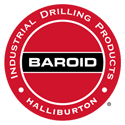Introduction to Solar Water Pumping
3 March 2014Introduction to Solar Water Pumping
Solar water pumping systems are a modern but field proven means of pumping water in locations where access to grid power is not available, or where the grid is not reliable. These systems use photovoltaic (PV) cells to convert sunlight into electricity to power DC pumps which can be used to pump groundwater or surface water.
This blog outlines the basics of solar water pumping, discusses potential applications and highlights some advantages and disadvantages of the method.
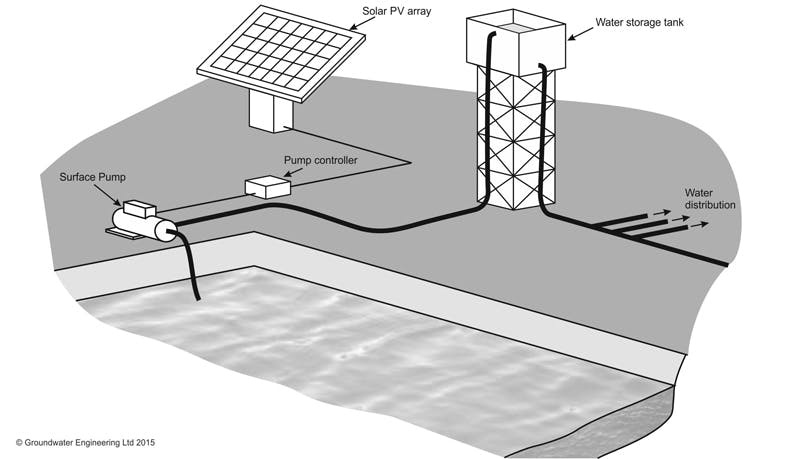
THE BASICS OF SOLAR WATER PUMPING
A typical system comprises the following elements:
- The water source: This could be a groundwater source, such as a well or borehole. Alternatively it could be a surface water source such as a river or pond.
- The pump: Depending on depth to water, pumps of either the submersible type or suction type can be used. In the most common solar systems the pumps are powered by DC current, which require considerably low operation and maintenance costs than conventional AC pumps and provides greater efficiency.
- The PV array: Arrays are formed from groups of photovoltaic (PV) cells, aligned to give suitable sun exposure at the site location. The PV cells generate DC power when the sun is shining. The PV array is normally mounted on a stand or mount to allow it to be aligned to maximize sun exposure.
- The pump controller: This unit allows the pump to be controlled and regulated and will be connected to the pump and electrical grounding system.
- Optional battery bank: The PV units only generate power when the sun is shining, and so do not work at night and on cloudy days, One solution to provide continuous pumping is to connect banks of batteries to the PV array to store excess power, to be drawn on when there is no sun.
- Optional generator back up: Another option is to provide a petrol or diesel driven AC generator: intelligent control units make the changing between power supplies automatic.
- Other renewable energy sources: Solar PV can also be combined with a wind turbine: taking maximum advantage of the natural energy resources – solar power when the sun is shining and wind power when the wind is blowing.
- Discharge pipework: This pipework carries the water from the pump to the storage tank and to the end use. It is important that the discharge pipework is designed so that the pipe materials, diameter, layout and fittings are arranged to minimize frictions losses in the pipework. This will help maximize the efficiency of the pumping system.
- Water storage tank: A storage tank is a key part of most solar pumping systems, to ensure constant availability of water, 24 hours per day. The tank capacity should be designed store enough water to allow for water demand on rainy or cloudy days (no sun days) when pumping will be limited. The size and dimensions of the storage tank should be determined based on the required number of days storage.
In reality, each solar water pumping system is unique. Getting the most benefit from a system requires research and design before the first PV module and pump is purchased and installed. Each component must be carefully matched, and proper planning is essential – so the final system will be efficient and reliable system and can function for many years to come.
APPLICATIONS
Possible applications for solar pumping systems include:
Irrigation and agricultural systems
The most common application of solar water pumping is to provide irrigation water or water for livestock, by pumping from groundwater wells or from surface water bodies. A well designed solar powered pumping system can transform the availability of irrigation water and reduce the money spent on generator fuel by farmers in areas where grid power is not available or is unreliable.
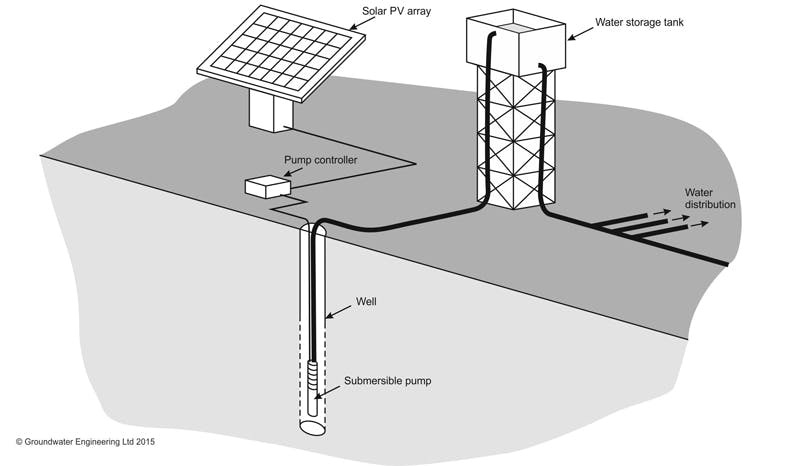
Remote habitations
Where people live a long way from reliable power supply, solar systems can be a good alternative to generator power supply. While the initial capital cost of a PV system may be greater than a generator, over the life of the system the low maintenance and zero fuel costs will make a solar PV system the cheaper option in the long term.
Temporary mining camps or construction camps
Solar pumping systems can be a great way to provide water to mining sites and construction sites. When used in combination with temporary drinking water treatment systems, they can be used to supply drinking water for workers.
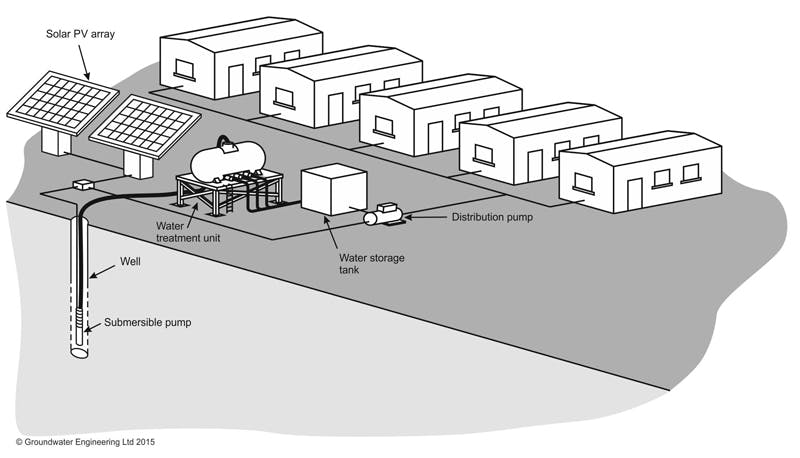
Emergency water supply
In disaster relief and refugee camp situations, solar pumping systems combined with temporary drinking water treatment units can be an effective way of very quickly providing safe and clean drinking water to affected populations. Solar powered systems are relatively lightweight and compact and suitable for air transportation. Once in the field they are quick to assemble and require little specialist knowledge to install and commission.
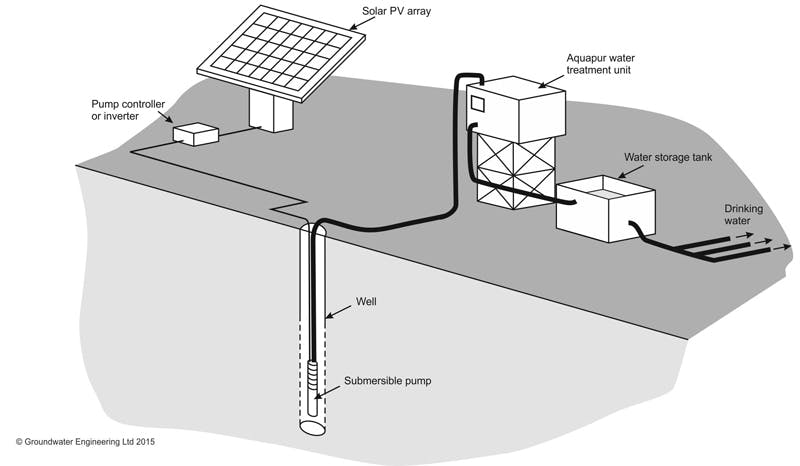
Dewatering systems
Dewatering systems normally require continuous pumping, 24 hours per day, 7 days per week. This means that solar power alone will not normally be adequate, and dewatering systems are normally powered by generators or from the grid. However, in hot and arid climates, such as the Middle East, parts of Africa and Australia, solar PV systems may have a role to play in reducing energy costs by displacing part of the conventional power sources used to run dewatering pumps.
Grid tie systems
If the required pumping is intermittent during daylight hours, or where the pumping demand is very low, the power output from the PV array may exceed the energy required to run the pumps. In these cases it is possible to connect the PV system both to the pump and to other electrical demands, either other on-site power demands of the pump operator, or to export power to the utility grid if that exists near the site. These systems are known as “grid tie” systems and can provide a source of income for the pump operator, by getting payments from the utility company for power exported.
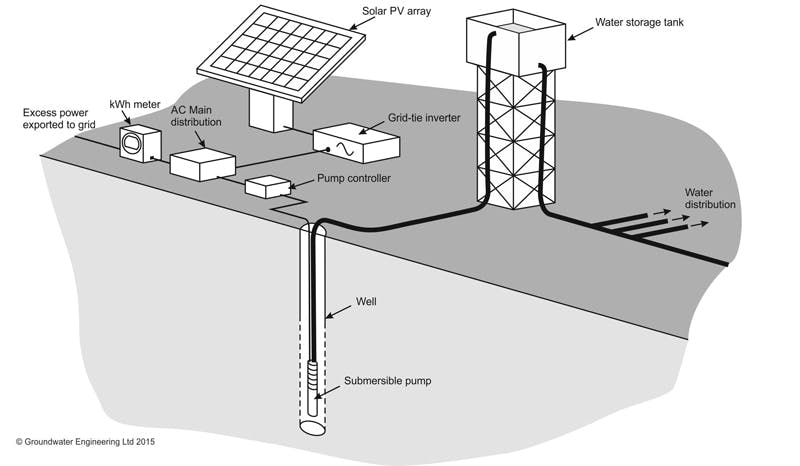
TYPES OF PUMPS FOR USE WITH SOLAR POWER SYSTEMS
Different types of pumps are classified as submersible pumps and surface pumps. Pumps are available to run on alternating current (AC) or direct current (DC) power. Solar pumping systems are normally based on DC pumps, although AC pumps are sometimes used on grid tie systems.
Submersible pumps operate differently to surface pumps (which are installed above water level and draw water up from shallow sources) by pushing water up from the pump to a holding tank or pressure tank. Submersible pumps are used to pump groundwater from deeper wells or boreholes, where surface pumps cannot be used because the water level is too deep below ground level (below approximately 6 meters depth).
Submersible borehole pumps are specially designed to have a small outside diameter so they can be suspended below the water level in the well and connected to an output pipe (called a riser pipe) that extends up to the surface. The right pump for each application will depend on the required pumping rates and pumping height and distance (which control the discharge head against which the pump must push the water).
A submersible pump is usually positioned in a well or borehole, although there are instances where a stream or pond is used as the source. A correctly sized submersible can pump water out of deep wells, from depths of up to 450 meters. Most models of pump are durable and can tolerate water with relatively high levels of salinity.
There are three main categories of submersible pump — centrifugal, helical rotor, and diaphragm pumps:
- Centrifugal pumps have an impeller that spins at high speeds. Because the rate of rotation is high, the flow rate from the pump is generally high. However, the delivery pressure, and therefore the lift (amount of pumping height) that can be attained, is usually lower than in other types of pumps.
- Helical rotor pumps are a type of “positive displacement” pump which can achieve higher lifts and also provide a flow rate great enough to meet most demands. Since the water needs to be carried through the pump body, the result is a lower flow compared to centrifugal pumps. However, with its higher pressure, a helical rotor pump can deliver water against higher heads.
- Submersible diaphragm pumps, another type of positive displacement pump, can pump up to about 20 liters per minute from shallow wells (less than 30 meters depth), or lower volumes from well depths down to approximately 70 meters. Although these pumps are less expensive than centrifugal or helical rotor pumps, they require significantly more maintenance.
Surface pumps draw water upward to the pump using the suction principle, and are used to move water from sources such as shallow wells, ponds, streams, and tanks, where the pump itself can be located within approximately 6 meters above the water level.
There are many types of pump available; the choice will depend on how much water per day needs to be moved and the height and distance to the delivery point (such as the storage tank). Pump efficiency and reliability can be improved if suction lift can be minimized to just a few meters.
There are three main categories of surface pumps – delivery, pressure and booster pumps:
- Delivery pumps are used to move water from one place to another. Some are capable of high pressure while others are intended mainly for moving large volumes at low pressure.
- Pressure pumps are often used for pressurizing small water systems in buildings – homes, schools, businesses or hospitals.
- Booster pumps are used to maintain pressure or flow – typically useful in towns or communities with unreliable water pressure particularly at times of high demand.
TYPES OF SOLAR PUMPING SYSTEMS
Solar pumping systems can be configured in various different ways, especially in relation to battery capacity (to store excess power) or grid connection (to export excess power).
Battery back up
Banks of batteries can be used store excess power, which can allow pumps to operate at night or on no sun days. These can be linked to generators so that the batteries are used preferentially, but the generator is used to continue to power the pumps when the batteries are depleted.
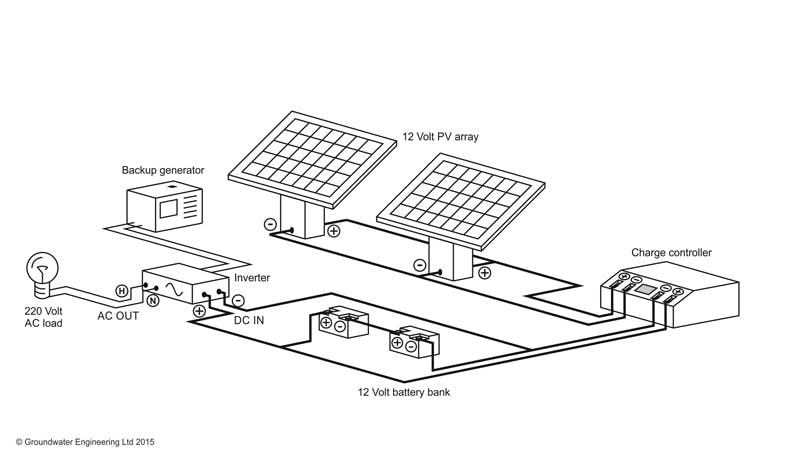
Grid connection
If the site is already connected to the utility grid, or can be easily connected, then there may be an option or to export power to the utility grid when the generated power from the PV units exceed the on-site demand. The grid will normally require AC power, so the DC output from the PV units will need to be converted by a grid tie inverter. These systems are only effective where the utility company runs a “net metering” or “feed in tariff” which allows users to sell power to the grid on a flexible basis and offset the cost of the exported power against power drawn from the grid at other times.
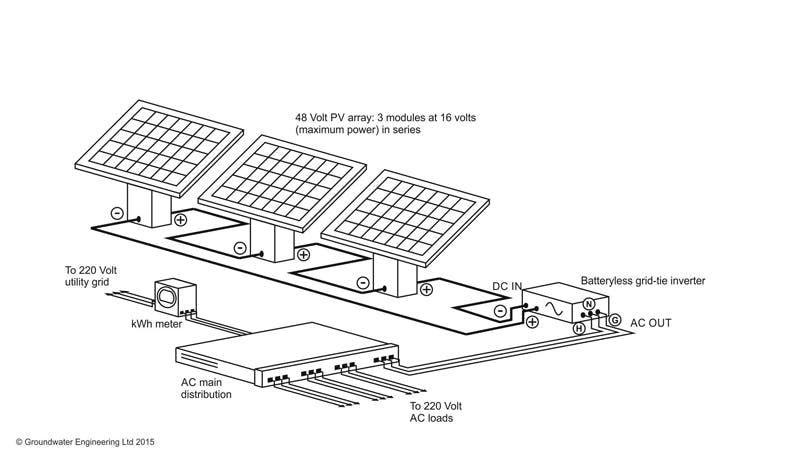
ADVANTAGES AND DISADVANTAGES OF SOLAR PUMPING SYSTEMS
Solar powered pumps can be a great way of providing reliable, low cost and low carbon pumping systems. But these systems are not a perfect solution for all scenarios, and it is worth recounting the advantages and disadvantages of these systems.
Advantages
- Can allow water pumping in remote locations or where grid power is unreliable – anywhere the sun shines
- Powered by clean, renewable energy
- Pumping availability increases in summer when water requirement is usually greater
- Very low operating costs – does not require fuel, requires only minimal service and maintenance, and is virtually free to operate
- Equipment is relatively portable and can be easily moved to meet seasonal or variable location needs
Disadvantages
- Potentially high capital costs
- Electrical output will be limited by daylight hours and bad weather. Water storage and battery back up may be required
CONCLUSION
In conclusion, solar pumping systems can provide real opportunities to improve water availability in areas where grid power cannot be relied upon, or where power costs are an impediment to effective water use. There is massive future potential for the application of these technologies worldwide.
For more information download Groundwater Engineering’s Technology Data Sheet on Solar Water Pumping.
Blog
Dewatering for Basement Construction
12 March 2016Groundwater can be a significant problem when excavating for basement construction. This blog discusses the available techniques that can be used to dewater during basement construction.
Read More
